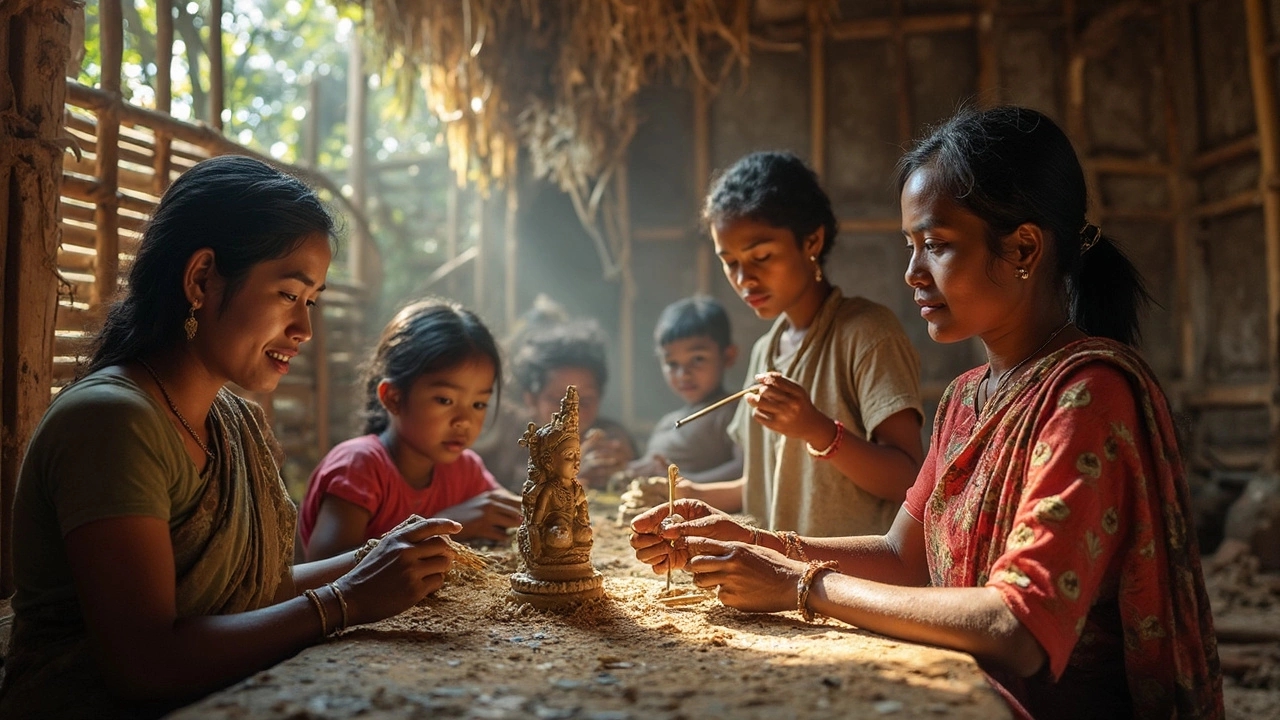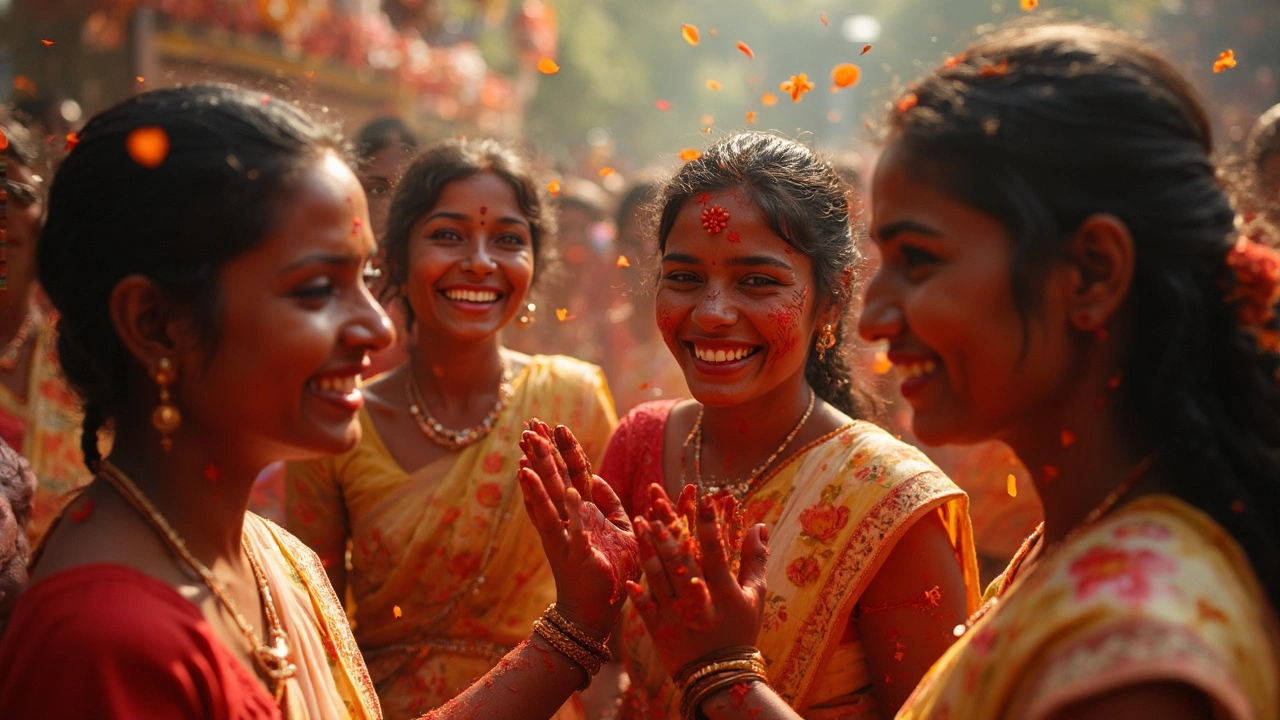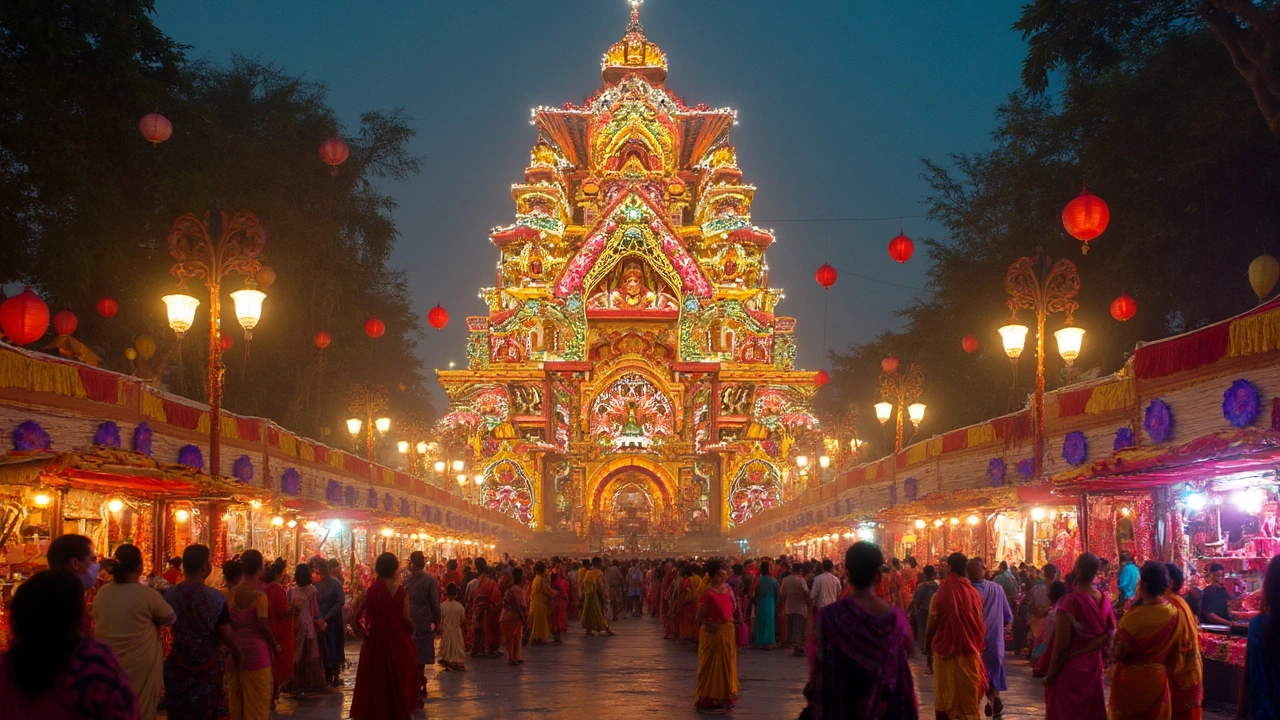Ask any Bengali which festival really matters, and the answer is almost always Durga Puja. This isn't just a holiday or a religious event—it's something bigger, louder, and a whole lot more fun. For five wild days, Bengal turns into a living, breathing carnival where art, faith, food, and old bonds come alive. People joke that even the air in Kolkata smells like new clothes and sweet incense when Puja season starts. But what makes Durga Puja feel so essential to Bengalis everywhere? Why does every Bengali—no matter if they’re in Kolkata, London, or New Jersey—count down the days till Puja? Time to step past the surface and find out.
The Story Behind Durga Puja: History and Myth Come Alive
The tale behind Durga Puja starts off epic. According to Hindu mythology, the goddess Durga was created by all the other gods when none of them could defeat the demon Mahishasura. They needed a power strong enough to save the world, so they pooled their energy and out came Durga—ten-armed, fierce, and unstoppable. Legends say her battle lasted nine days and nights until she finished Mahishasura in a final, dramatic clash on the tenth day. That’s why the festival ends with Vijaya Dashami, where the goddess’s victory and return to the heavens are celebrated with as much pomp as her arrival.
Back in the 18th and 19th centuries, Durga Puja was mostly a private affair for rich families in Bengal. Think lavish celebrations in big, colonial-era houses—sometimes lasting weeks—with music, food, and endless invitations. This slowly changed as communities started organizing "baroari" or public pujas. The very first community puja is traced to Guptipara in Hooghly district, around 1790, when friends who weren’t welcome at the wealthy “zamindars’” feast decided to pool resources and host their own. That spirit lives on in today’s huge public pandals, where everyone is welcome.
In modern Bengal, especially Kolkata, Durga Puja isn't just a religious thing—it's everywhere: in art, music, fashion, politics, and pop culture. There are more than 3,000 major public pandals in Kolkata alone every year. Each pandal is a temporary temple, but the designs range from traditional to wild and experimental. Think Hogwarts Castle, spaceship, or even a theme that mocks political scandals. It’s pretty common to find architects and college students working up until the last minute, putting together the latest showstopper. Winning the "best pandal" contest can be the highlight for any club or neighborhood association—bragging rights are huge.
By now, Durga Puja is listed by UNESCO as an Intangible Cultural Heritage of Humanity (since December 2021). That’s rare. It’s a formal nod to just how unique, artistic, and community-driven the whole celebration is—no matter where it happens in the world.
How Durga Puja Takes Over: Rituals, Music, and Dance
Just because Durga Puja feels like a citywide party doesn’t mean that rituals aren’t serious business. The actual religious part starts with Mahalaya, seven days before the main event. Early in the morning, radios all across Bengal play Birendra Krishna Bhadra’s "Mahishasuramardini"—a 90-minute audio drama that gives everyone goosebumps, young and old. It marks the goddess’s �3cstrong>Durga Puja�3c/strong> homecoming, and yeah, even in 2025, you’ll find people waking up before dawn just to tune in.
The idol-making itself is art. Kumartuli, a neighborhood in North Kolkata, is where most of the idols come from. You’ll see master sculptors working away at straw frames, slowly coating them with clay taken from the sacred Ganga river. There's a ritual where the clay has to be mixed with earth from outside a brothel, reminding everyone that the divine includes all corners of society—no one should be left out. If you ever get the chance, it's worth seeing Kumartuli in the weeks before Puja; the energy, creativity, and chaos are a festival in their own right.
The main puja days are Shashthi, Saptami, Ashtami, Navami, and Dashami. Each day has something special: flower offerings, lamp-lighting, chanting, or the famous "anjali" on Ashtami when crowds turn silent in prayer. Ashtami is often the peak; for most, this is the day to wear new clothes, hand out sweets, and head out on endless rounds of pandal-hopping—basically visiting as many themed pavilions as humanly possible in one night.
Music and dance are everywhere. Traditional "dhakis" (drummers) create a thunderous rhythm, especially during "Dhunuchi Naach." This is a wild, smoky dance done with clay pots full of burning coconut husk and incense. Anyone can join in—old men, kids, even that college dude in ripped jeans—and the energy, the smoke, and the sound combine in a way that gives you chills. Many places also organize contests, plays, and musical shows that go late into the night. Every neighborhood tries to one-up the others with better lighting, more creative idols, and bigger cultural programs.
It’s not all tradition—Puja is a selfie festival, too. Social media is flooded with group photos, boomerangs of traditional dances, six-yard sari fashion shoots, and even AI-generated memes of the goddess herself. It's a rare mix of old and new, and seems to stretch Bengal’s personality to its wildest form. It isn’t unusual to see my friends line up at iconic pandals at 2 a.m., just to beat the crowd and get the perfect photo for their Instagram reels. And yes, you’ll see street food vendors working double shifts to treat the endless flow of hungry festival-goers.

The Heartbeat of Kolkata: Pandal-Hopping, Food, and Family Bonding
During Puja, Kolkata basically refuses to sleep. Locals joke that traffic rules go on holiday, too—roads are blocked, buses take detours, and crossing the street becomes a sport. There’s something about the neon lights, buzzing crowds, and that over-excited uncle yelling “Ei dekho, oi toh Mona Lisa theme!” that makes regular city life feel like another universe. The best way to take it all in is by walking—just hop from one pandal to another with friends or family, following the growing hum of chatter and drumbeats.
Pandal-hopping is an art. People plan routes, rank must-see pandals, and some even hire guides or use apps to track queues. If there’s just one tip I can give: start in the evening and keep going till you drop. Major roads like Park Street, College Square, or Salt Lake become a living river of human energy. By the way, more than 35% of Kolkata’s population is out on the streets during Puja nights. If you want to experience the energy of Karnani Mansion or the creativity at Ekdalia Evergreen, get ready to wait—but you’ll find food stalls everywhere to keep you going. Try the phuchka (Bengali pani puri), rolls, or “bhog,” the free vegetarian feast offered at almost every pandal.
And Puja is not complete without new clothes. It’s a tradition—probably started by clever grandparents—to have at least one brand-new set of clothes for each day. Even expats living in Singapore or Toronto get their Puja parcels shipped by worried moms. For couples, there’s a game to see whose outfit gets the most compliments. My spouse, Lara, plans her sari lineup months in advance, and every year I end up reusing last year’s kurta. Guess who gets more likes on Instagram?
Here’s a hard fact: the economy during Puja goes nuts. In 2023, Kolkata saw an estimated Rs 40,000 crore ($5 billion) spent during the five days of Durga Puja, making it India’s largest temporary consumer event after Diwali. According to a survey by the Bengal Chamber of Commerce, shopping malls, street markets, airlines, hotels, and even streaming platforms report record traffic. Neighborhood clubs pour millions into elaborate themes. Even street decorators and idol sculptors are fully booked years in advance. Forget sleep—by late September, every Bengali shopkeeper is running on adrenaline and the promise of an epic payout.
| Year | Estimated Economic Impact (INR) | Number of Major Pandals (Kolkata) | Daily Crowd Size |
|---|---|---|---|
| 2023 | ₹40,000 crore | 3,000+ | 5 million (approx.) |
| 2022 | ₹37,500 crore | 2,800 | 4.8 million |
| 2019 (pre-pandemic) | ₹30,000 crore | 2,700 | 4 million |
Family reunions skyrocket. Kids come home from hostel, NRI uncles fly in, neighbors throw open their doors even to random acquaintances. Even old rivalries pause for a few days. If you ever wondered when to visit a Bengali household, shoot for Puja season. You’ll end up with a full stomach and maybe an invite to next year’s celebrations.
Small Details, Big Meaning: Symbolism, Sweets, and Surprises
It’s the tiny rituals and inside stories that give Puja its extra magic. For example, the idol shows Durga slaying Mahishasura, but look closer and you’ll see her four children—Lakshmi, Saraswati, Kartik, and Ganesh—beside her. They stand for wealth, wisdom, courage, and luck, making the festival feel like a blessing for all parts of life.
Flowers matter—a lot. There’s an obsession with the white-brown “kash phool,” wild grass that grows everywhere as monsoon ends, waving like white feathers on the wind. For most Bengalis, the sight of kash swaying in the sun means Puja is almost here. Vendors with baskets roam neighborhoods, selling garlands of fragrant jasmine, hibiscus, and marigold, all part of the offerings made to Durga every morning.
And then there are the sweets. Mishti (Bengali sweets) is practically its own religion during the festival. Classics like sandesh, rosogolla, and chomchom are everywhere, and even people on strict diets give up for a week. My friend swears his grandmother’s homemade patishapta (sweet-filled pancakes) is responsible for half his yearly calorie intake in October. Local sweet shops introduce new flavors every Puja, hoping to get written up on food blogs or go viral in WhatsApp groups. The verdict? If you leave Puja season without gaining at least two kilos, did you even celebrate?
One of my favorite underrated details is the special “Sindur Khela” on Dashami. Married women smear vermillion on the goddess and then each other as a blessing for happy married life. It's a scene of riotous red, drumming, and joyous tears—a classic photo op in newspapers and Insta stories, but also an emotional tradition for many families.
And finally, the immersion. Every idol is carried in crowds to the nearest river or lake, with hundreds of drummers leading the way. The heartbreak is real—people actually cry as their favorite Durga idol floats away. But right on cue, plans for “next year” begin before the last idol sinks below the waterline. There’s a sense that, as the saying goes, Durga Ma is always coming right back.

Durga Puja Beyond Bengal: How Bengalis Celebrate Worldwide
The need to celebrate runs so deep, Bengalis have taken Puja wherever they go. These days, you’ll find megawatt celebrations in places as far apart as New Jersey, Melbourne, Toronto, and Tokyo. Sometimes, it’s a small apartment hall with an imported clay idol. Sometimes, it’s giant community centers with thousands of guests and food trucks selling everything from biryani to vegan sweets.
Over 350 Bengali associations hold Durga Puja just in the US and Canada, each competing to make their event as authentic as possible. Organizers fly in priests and import real clay from the Ganga. Even the exact moment for rituals is set by Indian time zones, no matter the local sunrise. Families dress up, rehearse dances, and make homemade sweets that only taste right if you squabble over them in the kitchen. Some groups record their Mahalaya on YouTube for homesick members to play during breakfast.
It’s not just about nostalgia. Second-generation Bengalis—kids who’ve never visited Kolkata—learn songs, take up traditional dance, and debate what makes a perfect idol. The festival becomes a way to keep heritage alive even continents away. If you drop by a Puja in London or Sydney, don’t be surprised if someone hands you a plate of "khichuri" and asks you to join their WhatsApp group. It’s incredibly easy to slip into these communities, especially during Puja.
And the best part about global Pujas? They often blend local flavor. You’ll see Japanese drummers, Australian curry contests, or Canadian dance troupes right alongside Bengali classics. Puja is the one time everyone gets to celebrate what makes them feel at home.
So there it is. The most important Bengali festival is more than just a religious ritual. It’s five days where city streets turn into open-air art galleries, at least two dozen sweets threaten your waistline, and neighbors become lifelong friends over flower offerings and food. Durga Puja is the annual heart-thump that reminds every Bengali—wherever they are—that home isn’t a place, it’s a festival.
